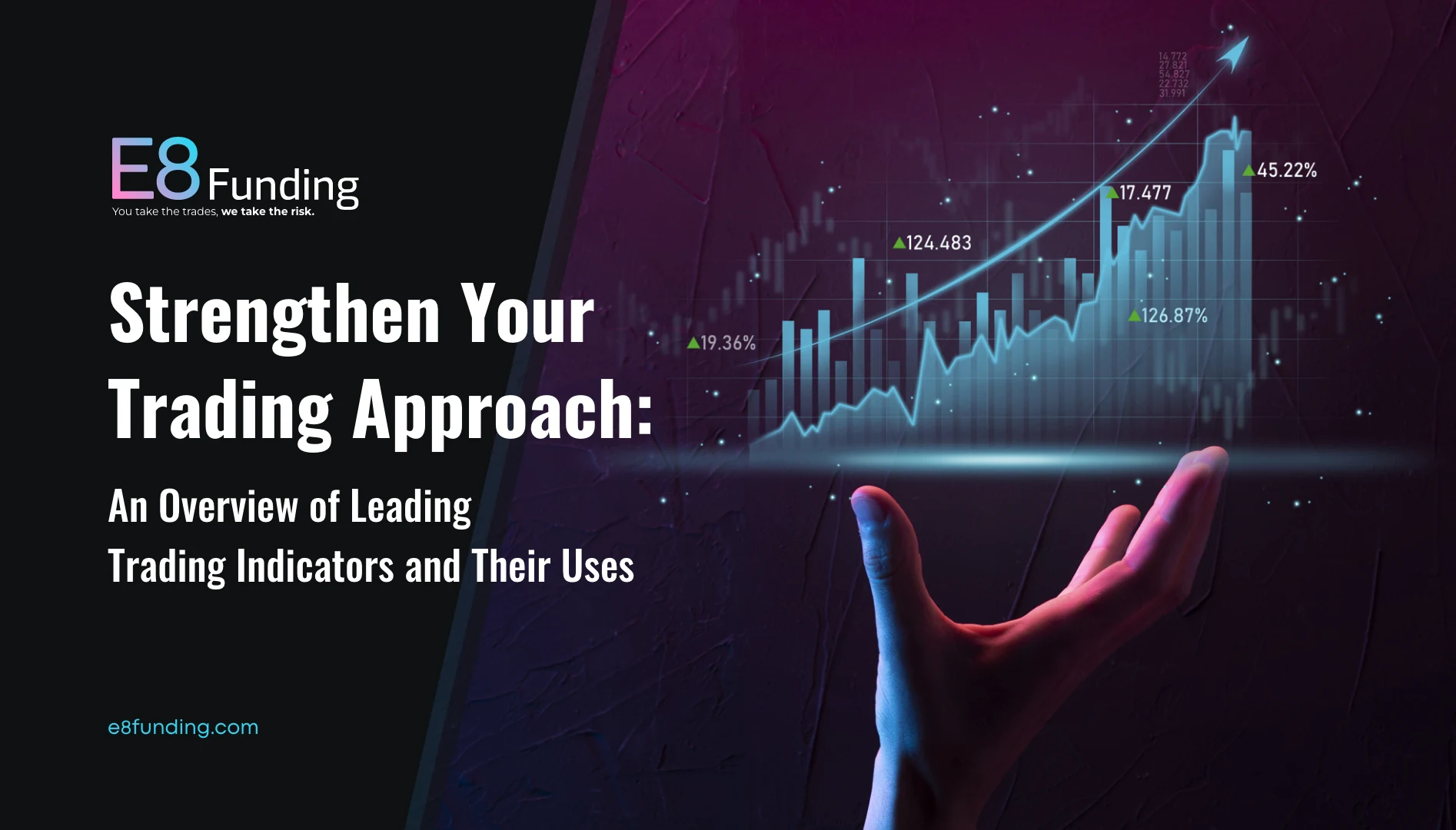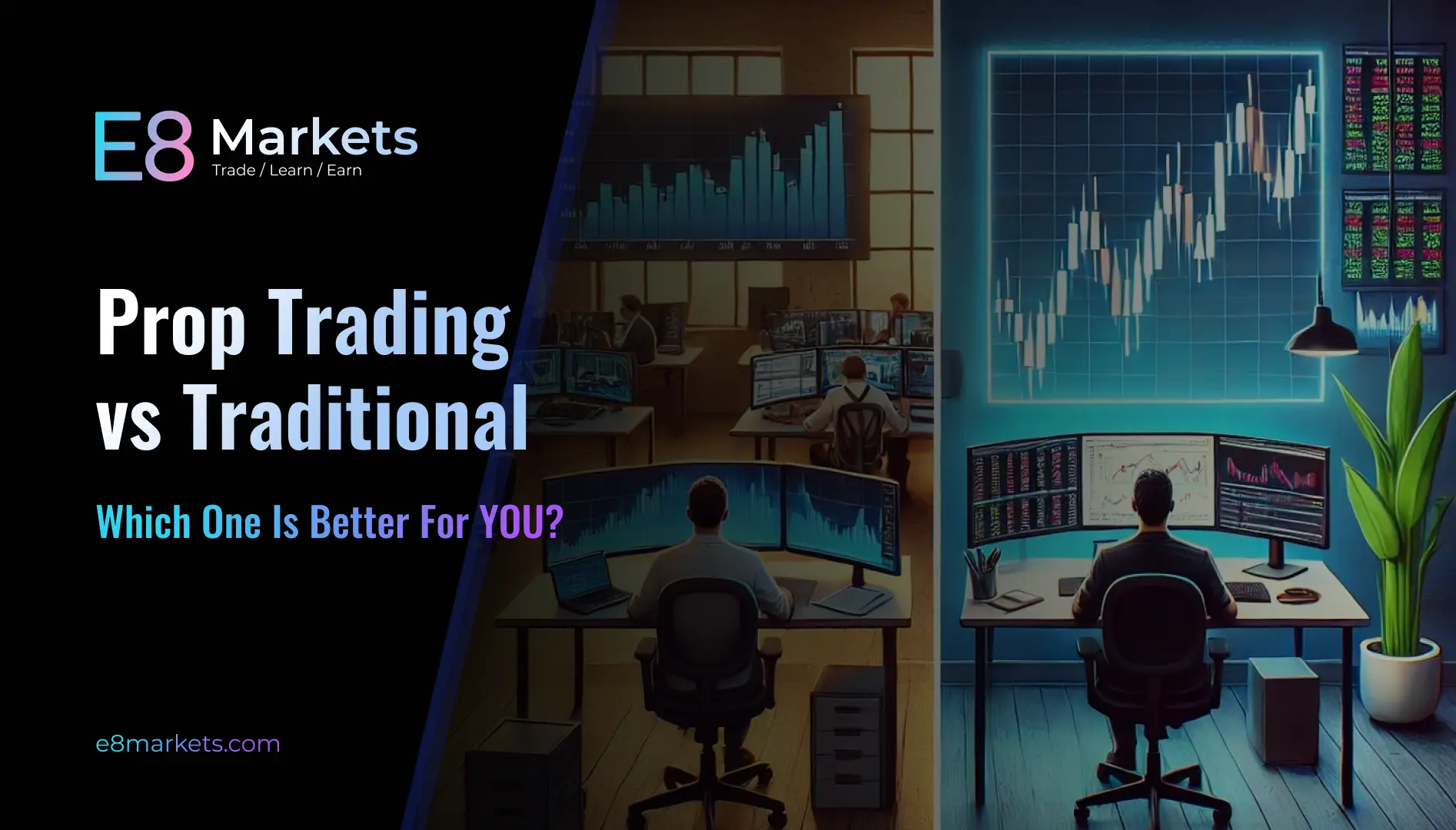How to Use Moving Averages in Forex Trading: A Complete Guide
Forex prices move in unpredictable ways. However, trends exist—and the moving average Forex strategy helps you see them. Without a clear view of the trend, it is easy to make bad trading decisions, enter trades too late, or exit too soon. Moving averages in trading helps you cut through the noise and focus on the bigger picture. They smooth out price movements and make it easier to spot when a currency pair is trending up or down. E8 Markets will show you how to use moving averages in Forex Trading. You will discover practical techniques to identify trends, time your trades, and bring structure and clarity to your trading decisions.
What Are Moving Averages in Trading?
A moving average is a tool that helps you understand the direction of the market by smoothing out price movements. Instead of looking at every small up and down movement, a moving average gives you a clearer view of the overall trend.
In Forex, prices constantly change, sometimes in unpredictable ways. This can make it hard to see whether a currency pair is actually going up (bullish trend) or down (bearish trend). A moving average solves this problem by averaging out past prices over a set number of periods. It creates a smooth line that helps you identify the general market direction.
For example, if you use a 50-period moving average on a daily chart, it takes the closing prices of the last 50 days, adds them up, and then divides by 50. This gives you an average price that updates daily. By looking at this line, you can easily see whether prices are generally moving up or down over time.
Short-Term vs. Long-Term Moving Average Forex Tools
You can adjust moving averages based on how many periods you include in the calculation. This affects how quickly they respond to price changes. Short-term moving averages (like the 9, 20, or 50-period moving averages) follow price movements closely. They react quickly to changes. They are useful for spotting short-term trends or trend reversals. However, they can also give more false signals because they are sensitive to price fluctuations.
Long-term moving averages (like the 100 or 200-period moving averages) move more slowly and help you see the bigger picture. These moving average settings for Forex are useful for identifying long-term trends and are often used by traders to confirm strong trend directions.

Types of Moving Averages and Their Characteristics
The moving average Forex tool comes in different forms, each with its own strengths and weaknesses. The two most commonly used types of moving averages are:
- Simple Moving Average (SMA)
- Exponential Moving Average (EMA)
Both will help you smooth out price movements and identify trends, but they behave differently. Understanding moving averages includes learning about the types. It will help you choose the right one for your trading style.
Simple Moving Average (SMA)
The Simple Moving Average (SMA) is the most basic and commonly used moving average in Forex trading. It helps you see the overall direction of the market by calculating the average price of a currency pair over a certain number of periods. This makes it easier to identify trends and filter out small, random price movements that can cause confusion. For example, if you apply a 50-day SMA to a chart, it will show the average price of the last 50 days. As each new day is added, the oldest day is removed, keeping the calculation up to date. This smooths out short-term fluctuations and allows you to focus on the bigger picture.
One of the main reasons traders use this moving average type is to determine whether a market is in an uptrend or a downtrend. If the price is consistently above the SMA, it indicates that the market is moving up. If the price stays below the SMA, it signals a downtrend. This makes it a valuable tool for identifying the overall market direction. You can also use the SMA to find entry and exit points for trades. A common approach is to buy when the price moves above the SMA and sell when it drops below. You can use two SMAs of different lengths to create the moving average crossover strategy.
Another important use of the SMA is to act as support or resistance. When a currency pair is in an uptrend, the SMA often acts as a support level, meaning the price tends to bounce off it and continue moving up. In a downtrend, the SMA can act as resistance, preventing the price from rising above it.
Advantages and Disadvantages of SMA
The biggest advantage of the SMA is its simplicity. It is easy to understand and apply. It provides a clear visual representation of the trend and helps you avoid reacting to minor price fluctuations. Another benefit is that it works well in markets that are trending steadily. When prices move in a clear upward or downward direction, the SMA provides reliable signals for traders to follow.
One of the main drawbacks of the SMA is that it reacts slowly to price changes. Since it gives equal weight to all past prices, it does not adjust quickly when new market movements occur. This can cause delays in trading decisions, especially in fast-moving markets where prices change rapidly. For example, if the market suddenly shifts direction, the SMA may take longer to reflect this change. This delay can result in traders entering or exiting trades later than they would like, which can impact profits.

Exponential Moving Average (EMA)
The Exponential Moving Average gives more importance to recent prices. This means it reacts faster to price changes. If there is a sudden price jump, the SMA will take longer to reflect the change because it treats all past prices equally. The EMA, on the other hand, will adjust more quickly because it prioritizes the latest price data.
Advantages and Disadvantages of EMA
One of the biggest advantages of the EMA is its speed. Since it reacts faster to price movements, you can use it to spot potential trends earlier than they would with an SMA. This is especially helpful in fast-moving markets, where quick decisions are important.
The EMA is also more useful for short-term trading strategies, such as day trading or scalping. Because it updates more quickly, traders who focus on short timeframes can get signals that better reflect what is happening in the market right now. Another benefit of the EMA is its ability to confirm trend changes. If a currency pair’s price suddenly reverses direction, the EMA will adjust more quickly. This will help you decide whether to enter or exit a trade before the trend is fully established.
While the EMA’s speed can be an advantage, it can also be a weakness. Because it reacts quickly to price changes, it is more sensitive to false signals. This means that in a market with a lot of small, random price movements, the EMA may give misleading signals that could cause traders to enter or exit trades too soon. For this reason, you should combine the EMA with other indicators or use it alongside an SMA to confirm signals. For example, you can use a slow-moving SMA to identify the overall trend and a faster EMA to find entry points.

How to Use Moving Averages in Forex
Moving averages will help you make better decisions and become a successful trader. By understanding how to apply them in different ways, you can improve your ability to analyze the market and find profitable trades. You can use moving averages to:
- Identify trends
- Spot trading opportunities with crossover strategies
- Use the moving average indicator as dynamic support and resistance
- Follow trends and stay in trades longer
Identifying Trends
One of the most important things you need to know is whether the market is in an uptrend, downtrend, or moving sideways. Trends tell you whether to buy, sell, or stay out of the market. Moving averages make it easier to identify these trends by smoothing out price fluctuations and showing the overall market direction. You can identify short-term trends using a 20-day or 50-day moving average and long-term trends using a 100-day or 200-day.
How to tell whether the trend is bullish or bearish? You can use the 200-day moving average as a technical indicator. Here is how:
- If the price is above the 200-day moving average, the market is in an uptrend, meaning buyers are in control. Traders often look for opportunities to buy in these conditions.
- If the price is below the 200-day moving average, the market is in a downtrend, meaning sellers are in control. Traders usually look for sell opportunities in these situations.
- If the price is moving sideways around the 200-day moving average, it suggests the market has no clear trend, which means that traders might wait for a stronger signal before entering a trade.
Spot Trading Opportunities with Crossover Strategies
Moving averages can also generate trade signals. One of the most popular ways you can use moving averages is through the moving average crossover strategy. A crossover happens when a short-term moving average crosses a long-term moving average. When this happens, there might be a change in trend. There are two main types of crossovers that traders watch for: the Golden Cross and the Death Cross. These signals help you decide when to enter or exit a trade based on trend direction.
While the Golden Cross suggests the start of an uptrend, the Death Cross signals a possible downtrend. A Golden Cross occurs when a short-term moving average, such as the 50-day MA, crosses above a long-term moving average, like the 200-day MA. This crossover signals that recent prices are rising faster than older prices. This indicates growing buying pressure. Traders often see this as confirmation that the market is turning bullish and may enter buy trades, expecting further price increases.
In contrast, a Death Cross happens when the short-term moving average crosses below the long-term moving average. This signals that recent prices are falling more quickly than past prices, meaning sellers are gaining control. Traders take this as a warning of a possible downtrend and may either close their buy trades to avoid losses or enter sell positions, expecting further price drops.
Both signals reflect a shift in momentum, but their effectiveness depends on market conditions. The Golden Cross works best when the market is already strengthening, while the Death Cross is more reliable in a well-established downtrend.
Also, both the Golden Cross and Death Cross work best in trending markets. When they appear in a choppy or sideways market, they can produce false signals because prices are not moving in a clear direction. In these conditions, a Golden Cross might briefly push the price above the long-term moving average but fail to continue upward, while a Death Cross might cause a short-lived dip before the price reverses.
Use the Moving Average Indicator as Dynamic Support and Resistance
Instead of using fixed horizontal support and resistance lines, you can use moving averages to identify areas where the price is likely to bounce or reverse. In an uptrend, prices tend to stay above a moving average. When the price drops, it often finds support at the moving average before continuing higher. This means that the moving average acts as a support level, where buyers step in and push the price back up. In a downtrend, prices tend to stay below a moving average. When the price rises, it often gets rejected at the moving average and continues downward. In this case, the moving average acts as a resistance level, where sellers regain control and push the price lower.
You can use this behavior to find trade opportunities. If the price bounces off a moving average in an uptrend, it can be a good time to enter a buy trade. If the price gets rejected by a moving average in a downtrend, it can be a good time to enter a sell trade.
Follow Trends and Stay in Trades Longer
The moving average indicator helps you stay in profitable trades longer. Many traders struggle with knowing when to exit a trade. They either close their position too soon and miss out on bigger profits, or they stay in too long and lose money when the trend reverses. Moving averages help solve this problem by acting as a guideline for holding onto trades during trending markets.
When the market is in an uptrend, traders use moving averages to help them stay in buy trades. As long as the price remains above the moving average, the uptrend is still strong, and there is no reason to exit the trade. In a downtrend, traders use moving averages to stay in sell trades. As long as the price remains below the moving average, the downtrend is still in place, and the trade can be held longer.
A common approach is to use a longer-term moving average, such as the 50-day or 200-day moving average, to determine when to stay in or exit a trade. If the price is still above the moving average, you can hold onto your buy trades. If the price is still below the moving average, you can keep your sell trades open.
Choosing the Right Moving Average for Your Trading Style
The best moving average for you depends on how often you trade and how long you hold positions. Here are examples:
- Scalpers (trades lasting seconds to minutes): Use the 9-period or 20-period EMA to react quickly to price movements and find fast entry and exit points.
- Day traders (trades lasting minutes to hours): Use the 20-period EMA for short-term signals and the 50-period SMA to confirm trends.
- Swing traders (trades lasting days to weeks): Use the 100-period or 200-period SMA to follow long-term trends and avoid market noise.
Short-term traders benefit from faster-moving averages that adjust quickly to price changes, while long-term traders rely on slower-moving averages for stability and trend confirmation.

Common Mistakes and How to Avoid Them
Moving Averages are very useful. However, you shouldn’t over-rely on them. Trading based only on the moving average crossover strategy can lead to false breakouts. A price moving above or below a moving average does not always mean a new trend is forming. Sometimes, the price briefly moves in one direction before continuing its original trend. Always confirm signals with other indicators. RSI helps spot overbought or oversold conditions, MACD measures trend strength, and volume confirms market support. If a moving average suggests a buy but RSI indicates overbought conditions, waiting for confirmation can prevent bad trades.
It is not smart to ignore market conditions, either. Moving average trading strategies work best in trending markets but often fail in sideways or choppy conditions, where prices frequently cross above and below the MA, leading to whipsaws and false signals. You must first identify if the market is trending or ranging before relying on moving averages. Economic indicators will help you, too. The International Monetary Fund’s (IMF) Global Financial Stability Report provides valuable insights into global market conditions. They will help you stay informed about broader financial trends (IMF Report). In a sideways market, waiting for a clear trend prevents unnecessary trades.
Also, false signals are more common on lower timeframes, like the 5-minute chart, where price fluctuations are frequent. In these short timeframes, prices often cross moving averages multiple times in a session, which makes it harder to identify a real trend. Using higher timeframes, such as the 1-hour or daily chart, helps filter out noise and provides more reliable trading signals.
Trade More Accurately with the Right Moving Averages
Moving averages in Forex trading will help you identify trends, filter out market noise, and make more informed trading decisions. They provide a clear structure for spotting opportunities, managing risk, and staying in trades longer. Whether you are a short-term trader looking for quick signals or a long-term trader following major trends, moving averages can enhance your strategy. When combined with other indicators and used in the right market conditions, they offer stronger trade confirmations and help reduce false signals. Mastering moving average trading strategies will give you a better understanding of price movements, improve your timing, and increase your confidence in the market.
Trade with E8 Markets
Start our evaluation and get opportunity to start earning.Suggested Articles:
Disclaimer
The information provided on this website is for informational purposes only and should not be construed as investment advice. Always conduct your own research and consult with a qualified financial advisor before making any investment decisions. We do not endorse or promote any specific investments, and any decisions you make are at your own risk. This website and its content are not responsible for any financial losses or gains you may experience.
Please consult with a legal professional to ensure this disclaimer complies with any applicable laws and regulations in your jurisdiction.








